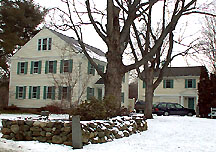Concord's District Schools: They're Still Among Us
by Joyce Woodman
former Staff Assistant, William Munroe Special Collections, Concord Free Public Library
 |
Concord families have always valued a good education for their children. As early as 1680, Constable Simon Davis signed an order of inquiry affirming that the town's young people were being taught in accordance with the law. By the late 18th century, school "societies" were established in several quarters, or neighborhoods, of Concord. In 1789, these independent societies were sanctioned by law and transformed into official school districts. In 1799, the town built a schoolhouse in each of its seven districts.
In 1850, the structures built in 1799 were repaired and improved. In some cases, the buildings were set back farther from the road. Each outlying district school (#2, East Quarter, Merriam's Corner; #3, South Quarter; #4, West Quarter, Factory Village; #5, Barrett's Mill; #6, Bateman's Pond; #7, North Quarter, Monument Street) had its own local advisory committee and a representative on the town's School Committee. A specific portion of the approved school budget was allocated to each district. The major portion went to the Centre District (#1), where there were multiple schools to serve the heavy population concentration. The school for older students was located for a time during the 1850s in the Town House. Subsequently referred to as the High School, it was available to students in the outlying districts upon qualification. They were required to provide their own transportation to town.
 |
Concord physician, statistician, and social historian Edward Jarvis wrote that the belfried wooden school building on Monument Square, in the Centre District, burned in the winter of 1819-1820. It was replaced in 1820 by the brick Masonic Hall, built in part through a contribution from the Corinthian Lodge. School was taught on the lower level, and the Masons met upstairs. In this schoolhouse, Henry David Thoreau taught for a brief period in 1837. Primary schools were also constructed in 1820 on sites near the New Hill Burying Ground, opposite the Emerson House, and on Sudbury Road.
The ungraded outlying schools -- each of them one to three miles from the town center -- were "little hives of industry and mischief," in the words of Bronson Alcott, School Superintendent from 1859 to 1865. Taught primarily by local young women, they were often staffed by male teachers during the winter term. The attendance of male students -- needed to work the farms during the rest of the year -- increased during the winter term. Male instructors were better able to manage the unruly behavior of the bigger boys.
 |
Poor ventilation, woodstoves and sheds, extreme conditions of summer heat and winter cold, well water obtained from the nearest house, outhouses distinctly lacking in privacy, and connected desk tops that the students banged noisily to disrupt class were all features of district school education. Despite these impediments, the students learned. Using approved textbooks, they recited paragraphs of history and rules of grammar, worked at reading, handwriting, oral spelling, and arithmetic, and sang and played games, as well.
The School Committee and Superintendent conducted regular reviews and visits to the schools. School exhibitions -- public programs of recitation and song by the students -- were held in the Town Hall each March. Thoreau, Emerson, and Superintendent Alcott all participated in the 1861 exhibition.
School Committee membership was opened up to women in 1870, when Ellen Emerson was elected to the body. Abby Hosmer, a former teacher, and Anne Damon were elected in 1876.
 |
In 1880, the eight-room Emerson School opened on the corner of Stow and Hubbard Streets. Soon, School Committee discussion arose over the issue of closing the district schools. Each district had always had a fair amount of control over the management of its school. Several district committees were reluctant to give up this local autonomy and to part from the long-established system of education. The School Committee ultimately decided to allow the districts time to accept that a better education awaited their children at the Emerson School in the center.
Over much of the 1880s, the districts individually petitioned the School Committee for closure and for transportation to the center. By 1887, consolidation had been achieved. The last outlying school had closed, and a new four-room school had opened in West Concord. Students were now transported to the town centers.
Today, some of the old district schoolhouses remain in use as private homes. Buildings that replaced the district schools have also been converted to purposes other than that for which they were originally constructed. The Concord-Carlisle Regional High School is centrally located, the elementary and middle schools situated in locations throughout the town. As in earlier centuries, town citizens and educators must still evaluate proposed (and sometimes controversial) changes to curriculum, teaching techniques, administration, and facilities as part of the process of providing the best possible education for Concord's school children.
Photos: ©2002 Richard Stevenson
Article appeared in the Concord Magazine, by Hometown Websmith, Concord, Mass., January/February 2002.
©2015. William Munroe Special Collections, Concord Free Public Library, Concord, Massachusetts.